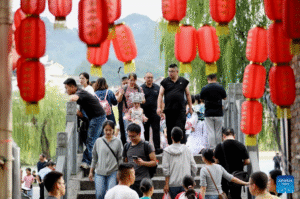15 cultural practices join UNESCO’s Representative List of Intangible Heritage

Travel Biz News —
The Intergovernmental Committee for the Safeguarding of the Intangible Cultural Heritage meeting held in the Colombian capital Bogota recently inscribed 15 more elements to the Representative List of Intangible Cultural Heritage of Humanity.
The 15 cultural practices inscribed in UNESCO’s Representative List of Intangible Heritage are –
Traditions of Pencak Silat, Indonesia
Although it is better known as a martial art, Pencak Silat is a long-standing tradition that encompasses numerous aspects: mental and spiritual, self-defence and aesthetics. The moves and styles of Pencak Silat reflect a strong artistic concern and require physical harmony with the accompanying music.
Provision of services and hospitality during the Arba’in visitation, Iraq
The provision of services and hospitality during the Arba’in visitation is a social practice performed across the central and southern regions of Iraq, where millions of visitors begin their pilgrimage towards the Holy City of Karbala to visit the Holy Shrine of Imam Hussein.
Irish harping, Ireland
The harp is Ireland’s national symbol and has been played for more than 1,000 years. Its music and bell-like sound captivate all who hear it and are celebrated in Irish mythology, folklore and literature.
Celestinian forgiveness celebration, Italy
Celestinian Forgiveness is a traditional celebration inspired by Pope Celestine V, who issued a historical bull as an act of partnership among local populations. Taking place in the city and province of L’Aquila, the tradition comprises a set of rituals and celebrations.
Ak-kalpak craftsmanship, traditional knowledge and skills in making and wearing Kyrgyz men’s headwear, Kyrgyzstan
Ak-kalpak craftsmanship is a traditional Kyrgyz handicraft. The Ak-kalpak is a traditional male hat made of white felt which bears deep sacral meanings. The Ak-kalpak’s shape resembles a snow peak, with the four sides resembling the four elements, and the edging lines symbolizing life.
Silat, Malaysia
Silat is a combative art of self-defence and survival rooted in the Malay Archipelago. Traced back to the early days of the Langkasuka Kingdom, Silat has now evolved into a fine practice of physical and spiritual training associated with traditional Malay attire, musical instruments and customs.
Kwagh-Hir theatrical performance, Nigeria
Kwagh-hir is a composite, visually stimulating and culturally rich theatrical performance rooted in the storytelling tradition of the Tiv people and the practice of creative storytelling. With time, storytellers began dramatizing their stories leading to the consolidation of the practice of Kwagh-hir in its present form.
Practice of traditional music and dance in Setesdal, playing, dancing and singing (stev/stevjing), Norway
In the practice of traditional music and dance in Setesdal, dance and music belong together. The melodies are named after the ‘gangar’ dance and the ‘stev’ songs, often performed in intervals between dancing and music-making, either solo or by two or more singers in dialogue with each other.
‘Hatajo de Negritos’ and ‘Hatajo de Pallitas’ from the Peruvian south-central coastline, Peru
The ‘Hatajo de Negritas’ and ‘Hatajo de Pallitas’ are two complementary traditional expressions featuring music and singing originating in the central department of Ica in Peru. Performed during Christmas celebrations in December and January they offer representations of biblical shepherds’ visit to the new-born baby Jesus and the arrival of the Wise Men.
Winter festivities, Carnival of Podence, Portugal
The Carnival of Podence is a social practice associated with the end of winter and the arrival of spring. The festivities take place over three days in village streets and houses where neighbours visit each other.
‘Ie Samoa, fine mat and its cultural value, Samoa
The ‘Ie Samoa is a finely hand-woven mat fastened at the hem with two rows of green and red feathers. Traditionally woven with strippings of the pandanus plant, the final product is silk-like and coppery in colour.
Drotárstvo, wire craft and art, Slovakia
Drotárstvo, wire craft and art, refers to the technique of manufacturing and using wire. The practice was developed in the 18th century when specialized craftspeople discovered the interesting properties of wire for the production of utility objects and devised a simple technique to produce and repair basic utensils without welding or soldering, a technique still used to this day.
Holy Week processions in Mendrisio, Switzerland
The Holy Week Processions take place in the historic town of Mendrisio , attracting over 10,000 spectators. During the processions, the city’s lights are turned off and the streets are lit by ‘transparencies’: translucent paintings mounted on wooden frames and lit from within.
Practices and craftsmanship associated with the Damascene rose in Al-Mrah, Syrian Arab Republic
The practices and craftsmanship associated with the Damascene Rose include medical, nutritional and cosmetic uses. The Damascene Rose begins to bloom in May, when the picking commences and the annual festival kicks off. Farmers and their families handpick the roses and then collect buds for tea.
Nuad Thai, traditional Thai massage, Thailand
Nuad Thai, traditional Thai massage, is regarded as part of the art and science of traditional Thai healthcare. As a non-medicinal remedy and manual therapy, it involves bodily manipulation to help rebalance the patient’s body, energy and structure to treat illnesses believed to be caused by the obstruction of energy flow along ‘sen’, lines crisscrossing the human body.
The Representative List seeks to enhance visibility for the traditional practices and know-how of communities without recognizing standards of excellence or exclusivity , according to UNESCO.
December 2019
Image : Traditions of Pencak Silat, Indonesia / UNESCO














